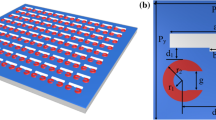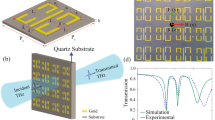Abstract
In this paper, a tunable slow light 2D metamaterial is presented and investigated. The metamaterial unit cell is composed of three metallic strips as radiative and non-radiative modes. Once introducing asymmetry, a transparency window induced by coupling between the dark and bright modes is observed. The transmission characteristics and the slow light properties of the metamaterial are verified by numerical simulation, which is in a good agreement with theoretical predictions. The impact of asymmetric parameter on transparency window is also investigated. Simulation results show the spectral properties and the group index of the proposed 2D metamaterial can be tunned by adjusting asymmetric structure parameter, temperature and also the metal used in the metamaterial. Furthermore, the electromagnetic field distributions, excited surface currents, induced electric dipole and quadruples, and slow light properties of the metamaterial are investigated in details as well as transmission spectral responses. The outstanding result is that, the 2D-metamaterial is in a high decrease of the group velocity and therefore slow light applications, because in the best state, the group velocity in our structure decreases by a factor of 221 at T=100 K using copper as metal in optimization asymmetric case.









Similar content being viewed by others
References
Tsakmakidis KL, Boardman AD, Hess O (2007) Trapped rainbow storage of light in metamaterials. Nature 450:397–401
Hau LV, Harris SE, Dutton Z, Behroozi CH (1999) Light speed reduction to 17 metres per second in an ultracold atomic gas. Nature 397(594)
Krauss TF (2008) Why do we need slow light?, Nat. Photonics 2:448
Vafapour Z (2016) Near-infrared biosensor based on classical electromagnetically induced reflectance (Cl-EIR) in a planar complementary metamaterial, Optics Communication, Manuscript Number: MB-1316, Under Review
Liu C, Dutton Z, Behroozi CH, Hau LV (2001) Observation of coherent optical information storage in an atomic medium using halted light pulses. Nature 409(6819):490–493
Bigelow MS, Lepeshkin NN, Boy RW (2003) Superluminal and slow light propagation in a room-temperature solid. Science 301:200
Okawachi Y, Bigelow MS, Sharping JE, Zhu Z, Schweinsberg A, Gauthier DJ, Boyd RW, Gaeta AL (2005) Tunable all-optical delays via Brillouin slow light in an optical fiber, phys. Rev. Lett. 94(153902)
Pendry JB, Schurig D, Smith DR (2006) Controlling electromagnetic fields. Science 312:1780–2
Boyd RW, Gauthier DJ, Gaeta AL (2006) Applications of slow light in telecommunications. Opt Photonics News 17(4):18–23
Cardenas J, Foster MA, Sherwood-Droz N, Poitras CB, Lira HLR, Zhang B, Gaeta AL, Khurgin JB, Morton P, Lipson M (2010) Wide-bandwidth continuously tunable optical delay line using silicon microring resonators. OPTICS EXPRESS 18(25):26525
Khurgin JB (2005) Optical buffers based on slow light in electromagnetically induced transparent media and coupled resonator structures: comparative analysis. JOSA B 22(5):1062–1074
Lauprṫre T, Ruggiero J, Ghosh R, Bretenaker F, Goldfarb F (2009) Observation of electromagnetically induced transparency and slow light in the dark state–bright state basis,. Opt Express 17(22):19444–19450
Zhang L, Tassin P, Koschny T h, Kurter C, Anlage SM, Soukoulis CM (2010) Large group delay in a microwave metamaterial analog of electromagnetically induced transparency. Appl Phys Lett 97(241904). doi:10.1063/1.3525925
He XJ, Li TY, Wang L, Wang JM, Tian XH, Jiang JX, Geng ZX (2014) Electromagnetically induced transparency and slow light in a simple complementary metamaterial constructed by two bright slot-structures. Appl Phys A 16(2):799–804
Vafapour Z, Zakery A (2015) New approach of plasmonically induced reflectance in a planar metamaterial for plasmonic sensing applications. Plasmonics 11(2):609–618
Khurgin JB (2010) Slow light in various media: a tutorial. Adv Opt Photon 2:287–318
Tassin P (2015) Slow-Light Metamaterials. Nanoscale Quantum Optics:77
Parvinnezhad-Hokmabadi M, Kim J-H, Rivera E, Kung P, Kim SM (2015) Impact of substrate and bright resonances on group velocity in metamaterial without dark resonator. Sci Rep 5(14373). doi:10.1038/srep14373
Vafapour Z, Alaei H (2016) Achieving a high Q-factor and tunable slow-light via classical electromagnetically induced transparency (Cl-EIT) in metamaterials, Plasmonics, doi:10.1007/s11468-016-0288-0
Vafapour Z, Forouzeshfard MR (2016) Disappearance of plasmonically induced reflectance by breaking symmetry in metamaterials, Plasmonics, Pending for revision
Qin G, Jose R, Ohishi Y (2007) Stimulated Raman scattering in tellurite glasses as a potential system for slow light generation. J Appl Phys 101(9):093109
Song KY, Herrez MG, Thvenaz L (2005) Observation of pulse delaying and advancement in optical fibers using stimulated Brillouin scattering. Opt Express 13(1):82–88
Palinginis P, Sedgwick F, Crankshaw S, Moewe M, Chang-Hasnain C (2005) Room temperature slow light in a quantum-well waveguide via coherent population oscillation. Opt Express 13(24):9909–9915
Lin CX, Zhang W, Huang YD, Peng JD (2007) Zero dispersion slow light with low leakage loss in defect Bragg fiber. Appl Phys Lett 90(3):031109
Krauss TF (2007) Slow light in photonic crystal waveguides. J Phys D Appl Phys 40(9):2666–2670
Kocaman S, Yang X, McMillan JF, Yu MB, Kwong DL, Wong CW (2010) Observations of temporal group delays in slow-light multiple coupled photonic crystal cavities. Appl Phys Lett 96(22):221111
Karalis A, Lidorikis E, Ibanescu M, Joannopoulos JD, Soljaci M (2005) Surface-plasmon-assisted guiding of broadband slow and subwavelength light in air. Phys Rev Lett 95(6):063901
Boller KJ, Imamoglu A, Harris SE (1991) Observation of electromagnetically induced transparency. Phys Rev Lett 66:2593–2596
Fleischhauer M, Imamoglu A, Marangos JP (2005) Electromagnetically induced transparency: optics in coherent media. Rev Mod Phys 77:633–673
Alzetta G, Gozzini A, Moi L, Oriols G (1976) An experimental method for the observation of R. F. transition and laser beat resonances in oriented Na vapor. Nuovo Cimento B 36:5
Parvinnezad-Hokmabadi M, Philip E, Rivera E, Kung P, Kim SM (2015) Plasmon induced transparency by hybridizing concentric-twisted double split ring resonators. Sci Rep 5(15735). doi:10.1038/srep15735
Liu N, Langguth L, Weiss T, Kastel J, Fleischhauer M, Pfau T, Giessen H (2009) Plasmonic analogue of electromagnetically induced transparency at the Drude damping limit. Nat Mater 8: 758
Vafapour Z, Zakery A (2015) New regime of plasmonically induced transparency. Plasmonics 10(6):1809–1815
Tassin P, Koschny T, Soukoulis CM (2014) Field enhancement with classical electromagnetically induced transparency, nonlinear. Tunable and Active Metamaterials 200:303–319. doi:10.1007/978-3-319-08386-5-15
Chiam SY, Singh R, Rockstuhl C, Lederer F, Zhang W, Bettiol AA (2009) Analogue of electromagnetically induced transparency in a terahertz metamaterial. Phys Rev B 80(15):153103
Singh R, Al-Naib IAI, Yang Y, Chowdhury DR, Cao W, Rockstuhl C, Ozaki T, Morandotti R, Zhang W (2011) Observing metamaterial induced transparency in individual Fano resonators with broken symmetry. Appl Phys Lett 99(20):201107
Liu X, Gu J, Singh R, Ma Y, Zhu J, Tian Z, He M, Han J, Zhang W (2012) Electromagnetically induced transparency in terahertz plasmonic metamaterials via dual excitation pathways of the dark mode. Appl Phys Lett 100(13):131101–4
Li Z, Ma Y, Huang R, Singh R, Gu J, Tian Z, Han J, Zhang W (2011) Manipulating the plasmon-induced transparency in terahertz metamaterials. Opt Express 19(9):8912–8919
Weiss T, Granet G, Gippius NA, Tikhodeev SG, Giessen H (2009) Matched coordinates and adaptive spatial resolution in the fourier modal method. Opt Express 17(10):8051–8061
Tikhodeev SG, Yablonskii AL, Muljarov EA, Gippius NA, Ishihara T (2002) Quasiguided modes and optical properties of photonic crystal slabs. Phys Rev B 66(045102)
Stephen DG (2011) Introduction to the finite-difference time-domain (FDTD) method for electromagnetics. Synthesis Lect Comput Electromagn 6(1):1–250. doi:10.2200/S00316ED1V01Y201012CEM027
Cai W, Shalaev V (2010) Optical metamaterials fundamentals and application, Springer. London: Springer New York Dordrecht Heidelberg:157
Burresi M, Oosten DV, Kampfrath T, Schoenmaker H, Heideman R, Leinse A, Kuipers L (2009) Probing the magnetic field of light at optical frequencies. Science 326:550
Ashcroft NW, Mermin ND (1976) Solid state physics, (Holt Rineheart and Winston)
Alici KB, Ozbay E (2009) Low temperature behavior of magnetic metamaterial elements. New J Phys 11 (043015)
Chen X, Grzegorczyk TM, Wu B -I, Pacheco J, Komg JA (2004) Robust method to retrieve the constitutive effective parameters of metamaterials. Physics Rev E 70(016608)
Zhang F, Potet S, Carbonell J, Lheurette E, Vanbesien O, Zhao X, Lippens D (2008) Negative-zero-positive refractive index in a prism-like omega-type metamaterial. IEEE Trans Microwave Theory Tech 56(11):2566–2573
Acknowledgments
Zohreh Vafapour would like to express her special thanks to Dr. Jacob B. Khurgin from The Johns Hopkins University for his useful discussions.
Author information
Authors and Affiliations
Corresponding author
Rights and permissions
About this article
Cite this article
Vafapour, Z., Alaei, H. Subwavelength Micro-Antenna for Achieving Slow Light at Microwave Wavelengths via Electromagnetically Induced Transparency in 2D Metamaterials. Plasmonics 12, 1343–1352 (2017). https://doi.org/10.1007/s11468-016-0392-1
Received:
Accepted:
Published:
Issue Date:
DOI: https://doi.org/10.1007/s11468-016-0392-1




